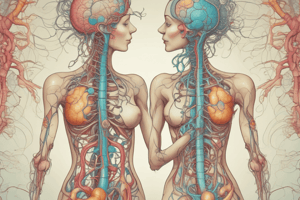Podcast
Questions and Answers
What is one condition that must be met for a substance to be classified as a neurotransmitter?
What is one condition that must be met for a substance to be classified as a neurotransmitter?
- It must be a neuromodulator.
- It must be present in the terminal. (correct)
- It must only bind to one type of receptor.
- It must be released before an action potential occurs.
What defines electrical synapses compared to chemical synapses?
What defines electrical synapses compared to chemical synapses?
- They have a larger synaptic gap.
- They use neurotransmitters to signal.
- They are slower in transmitting signals.
- They do not have a receptor or binding site. (correct)
What is the primary function of LTP (long term potentiation) in synaptic function?
What is the primary function of LTP (long term potentiation) in synaptic function?
- Blocking neurotransmitter release.
- Enhancing chemical synaptic transmission. (correct)
- Causing habituation to stimuli.
- Facilitating neuronal death.
Where does the axon hillock primarily play a significant role?
Where does the axon hillock primarily play a significant role?
What mechanism is involved in the rapid decrease of a response to stimulus after repeated exposure?
What mechanism is involved in the rapid decrease of a response to stimulus after repeated exposure?
What is the primary function of the autonomic nervous system?
What is the primary function of the autonomic nervous system?
Which part of the brainstem is responsible for fine movements and balance?
Which part of the brainstem is responsible for fine movements and balance?
How are neurotransmitters typically released into the synaptic gap?
How are neurotransmitters typically released into the synaptic gap?
What does the term 'kiss and run' refer to in synaptic transmission?
What does the term 'kiss and run' refer to in synaptic transmission?
Which of the following synapse types sends messages from dendrites to other dendrites?
Which of the following synapse types sends messages from dendrites to other dendrites?
What is the role of the superior colliculus?
What is the role of the superior colliculus?
Which of the following brain regions is a part of the hindbrain?
Which of the following brain regions is a part of the hindbrain?
What are the three pools of neurotransmitters involved in synaptic transmission?
What are the three pools of neurotransmitters involved in synaptic transmission?
Flashcards are hidden until you start studying
Study Notes
The Nervous System
- The nervous system is composed of the central nervous system (CNS) and peripheral nervous system (PNS).
- The CNS comprises the brain, spinal cord, and cerebellum.
- The PNS involves nerves that control movement.
- The autonomic nervous system communicates chemically using hormones released by ductless glands, and the pituitary gland is considered the master gland.
- The cranial nervous system manages input and output from the head.
- The brainstem receives sensory information and directs it to the rest of the body.
- It is divided into the hindbrain (fine movements, balance, cerebellum, reticular formation), midbrain (tectum which includes the superior (vision) and inferior colliculus (audition) as well as the tegmentum involved in movement), and diencephalon (hypothalamus).
The Synapse
- The synapse is a gap between the axon and dendrite, approximately 20-40 nm wide.
- Neurotransmitters are released across this gap.
- If all the transmitter is not absorbed, it is re-uptaken.
- There are three pools of neurotransmitters: ready releasable, recycling, and reserve.
- Types of synapses include: dendrodendritic, axodendritic, axoextracellular, axosomatic, axosynaptic, axoaxonic, and axosecretory.
Neurotransmitters
- The steps in a neurotransmitter life cycle include synthesis, storage, release, receptor interaction, inactivation, re-uptake, and degradation.
- The five criteria for classifying something as a neurotransmitter are: present in the terminal, released on firing, emulates firing on organ or another neuron, re-uptake for inactivation, and blocking stimulation.
- Neurotransmitters bind to receptors like a lock and key.
- Neurons typically have only one type of receptor.
Synaptic Transmission
- Electrical synapses are 2.5 nm apart and allow bi-directional flow of ions.
- They are used in situations requiring fast response.
- Electrical synapses lack receptors or binding sites, but have connexons.
Learning and Memory
- Habituation: Decrease in response strength after repeated exposure to a stimulus.
- Long-term potentiation (LTP) is strengthened synaptic transmission as a consequence of co-incident pre- and post-synaptic activity.
- LTP is a leading candidate for memory mechanism.
Other Key Concepts
- The axon hillock is the starting point of the axon with concentrated voltage sensitive channels.
- Depolarization occurs at -50mV.
- Patch clamp: Electrophysiological technique recording whole cell or single channel currents across membranes.
Studying That Suits You
Use AI to generate personalized quizzes and flashcards to suit your learning preferences.





